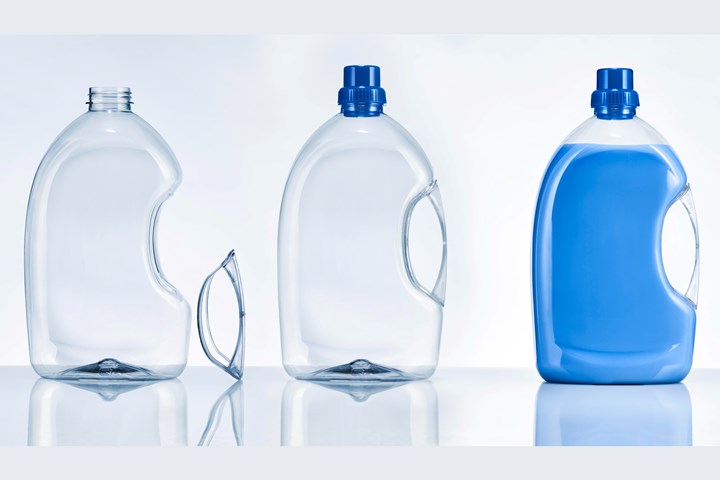All-rPET Bottles with Glued-in Handles Save Material
At K 2022, KHS is showing a 2.3 L PET bottle with glued-in handle that offers 10% material savings and other advantages over clip-in handles. Bottle and handle are both 100% rPET.

Energy savings, greater design freedom, high clarity and lack of seams are advantages claimed by KHS for its new 2.3 L rPET bottle with glued-in handle vs. PET with clip-in handle or extrusion blown polyolefin handleware. (Photo: KHS)
KHS has a new option for stretch-blown PET containers with handles: Besides offering clip-in handles slotted into place mechanically, KHS is exhibiting at K 2022 a new 2.3-liter PET bottle with a glued-in handle. Both bottle and handle are 100% rPET. The company says this design, together with the preferential heating technology on its stretch-blow machines, provides 10% material savings vs. bottles with clip-in handles. Glued-in handles reportedly also require a simpler contour and increase efficiency in processing.
In addition, the clear PET bottle has a marketing advantage over translucent extrusion blow molded HDPE or PP handleware. And the lack of seams in the stretch-blown PET bottle reportedly contributes to excellent performance in rigorous drop tests.
The new bottle results from an 18-month cooperative project between KHS and Logoplaste Innovation Lab, a division of the Portugal-based , which has 63 bottle-making plants in 17 countries. It’s three Innovation Hubs are located in Portugal, U.K. and Plainfield, Ill. The goal of the project was to design a bottle for home-care products with the smallest possible carbon footprint. The project drew on KHS’s experience in selecting a suitable adhesive from prior projects.
Related Content
-
What to Look for in High-Speed Automation for Pipette Production
Automation is a must-have for molders of pipettes. Make sure your supplier provides assurances of throughput and output, manpower utilization, floor space consumption and payback period.
-
Multilayer Solutions to Challenges in Blow Molding with PCR
For extrusion blow molders, challenges of price and availability of postconsumer recycled resins can be addressed with a variety of multilayer technologies, which also offer solutions to issues with color, processability, mechanical properties and chemical migration in PCR materials.
-
How to Extrusion Blow Mold PHA/PLA Blends
You need to pay attention to the inherent characteristics of biopolymers PHA/PLA materials when setting process parameters to realize better and more consistent outcomes.


